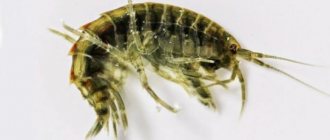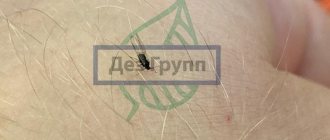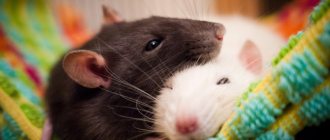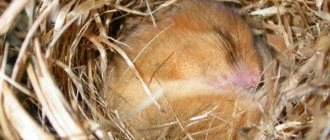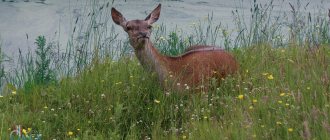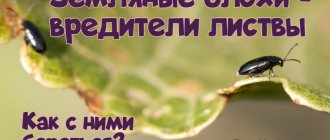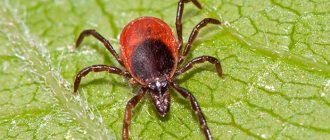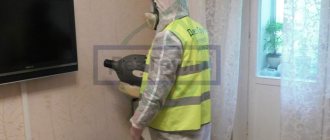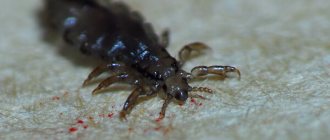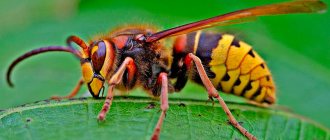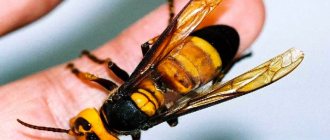Termites
- These are insects related to cockroaches. They resemble ants. Most termites do not have vision. They communicate with each other through vibrations and pheromones. Interesting fact! Each termite colony produces an odor unique to that colony.
Termites create a huge squad and live in families. Each family member has his own name (king, queen, worker, nanny, soldiers) and does his own thing.
Typically, termites spend all their time in their nests, so they can only be seen during the flight period.
Termites are rare in Russia. If you suspect that you have found a termite, make sure that you saw it and not a winged ant.
Photos and descriptions of species
The appearance of termites depends on the habitat in which they are found, their species and origin. But there are termites that live outside the countries of the former USSR, and they have some similarities:
Termites can range in size from 4 millimeters to 1.5 centimeters.- The body of termites consists of two parts: the first part is a large head, on which there are long mustaches, the second part is an elongated body with a blunt end.
- Termites of the worker caste have soft white bodies and can be visually confused with larvae at the finish line of their development.
- Termites - soldiers are dark brown in color with a large head, on which there are two huge claws - mandibles, which they use when the colony is in danger.
- Termite kings and queens visually resemble fat larvae, which have the head of an adult insect. Their activity consists of reproducing colonies inside the nest.
- Reproductive individuals have rigid bodies, can be almost black in color, and at a certain point in time acquire wings in order to establish a new colony during flight.
According to statistics, today scientists have discovered about three thousand species of termites. In Russia you can find only three species.
Termite mound is a complex structure
As the name itself suggests, a termite mound is a “house” in which termites live. What is it, what features are inherent in such a structure and what are the rules for the existence of a “population” in it?
After a sufficient number of working individuals have been born, the latter begin to build a new reliable shelter for the future colony, the location of which is determined by the young couple. Amazingly, insects the size of ants have the incredible ability to build huge “castles” with intricate labyrinths of internal passages, towering more than 8 meters above the soil surface. A record-breaking termite mound, the height of which was 12.8 meters above the surface of the earth, was recorded in Zaire. In the shade of such structures - the most complex of non-human structures - buffaloes, elephants and other large animals hide from the scorching sun. Termite mounds are varied in shape: some resemble cathedrals, others are horizontally oriented from north to south, which is why they are called “magnetic”. This arrangement contributes to minimal penetration of solar radiation and the formation of a constant microclimate: humidity and temperature.
Yellow-necked termite
- In Latin the name is Kalotermes flavicollis.
- They are also called yellow-breasted termites and yellow-breasted termites.
- On the territory of Russia it can be found in Sochi near the Black Sea coast and a little to the south.
- Places where termites prefer to live: rotten wood, decaying stumps, hollows. They usually live in entire colonies of hundreds to thousands.
- They can live in old houses if the wood has reached a stage that suits them.
- Flight period – July – September.
So fresh, clean
9 Termites are extremely clean insects. Colonies spend a lot of time grooming each other to prevent disease.
10. Termite queens dictate what role the offspring will have by feeding them their pheromone-laden feces. The type of pheromone the queen releases determines the future role of the eater.
11. Many different pheromones are released from glands located on the abdomen. Substances convey a variety of information to other members of the caste, including knowledge of where food is, threats, and much more.
12. Termites have sensory organs located at the base of their antennae and tibiae that allow them to sense vibrations. Scientists have noticed that some species select food sources by perceiving vibroacoustic signals emitted by different parts of the tree.
Far Eastern termite
- Its Latin name is Reticulitermes speratus.
- It is also called Japanese termite.
- From the name it is clear where termites can be found in Russia - in the Vladivostok region.
- Usually, this species can be found on the territory of ports, so it is clear where they come from into Russia (with cargo from China, Japan, where their habitat is familiar).
- They prefer to live in fallen trees, stumps, wooden buildings, rubble of boards, nest, sometimes you can find this species in the soil.
- Flight period – May – July.
Habitat
There are about 2,800 species of termites in the world, and most of them are indigenous to the tropics and subtropics. We have only 2 species in Russia - in the Sochi and Vladivostok areas. But with the development of cities and powerful heating systems, roads to the north opened for termites. They wait out the winter in heated buildings, and when it gets warmer, they move on. Termites have now been spotted even in Hamburg, a city located far from the warmest part of Germany.
Termite habitats
Photophobic termite
- In Latin it has a name - Reticulitermes lucifugus.
- An alternative name is European termite.
- On the territory of Russia it can be found both in the Caucasus and Volgograd, and on the Black and Caspian seas.
- Nests are made in the ground at a depth of up to half a meter, under the roots of stumps, bushes, trees and grasses; they often settle in greenhouses.
- Flight period: April – May.
If you suddenly find a termite in an apartment or house, as you think, then there are two options for the development of events:
- Either it came to you with the groceries you brought from the store, or after a vacation along with your luggage.
- Or you may have confused a termite with another insect. To find out exactly who you found, you can take the pest to the Center for Hygiene and Epidemiology to clarify the origin of the individual.
Behavioral differences
Both interact with the tree, but in different ways. For example, termites eat the wood in which they nest. Carpenter ants simply chew wood for the colony. They don't eat it, they just push it out through the openings of the galleries. Therefore, if you see small piles of wood shavings (insect waste) under the holes, these are ants or borers .
Ants look for damp, damaged wood to dig a nest. Termites eat healthy wood.
Another obvious difference is how the wooden tunnels look. The tunnels and carpenters' galleries are smooth. Termite galleries are rough and uneven because they are filled with layers of soil and dirt.
A mud tube indicates the presence of termites. Built outside the walls, between the ground and the tree, they serve as passages.
Termite nests
Termite nests, their appearance and location depend on the type of termite.
The largest nests that grow from the ground upward are built by African termites of the species Macrotermes bellicosus. Their structure can reach up to 13 meters in length and be 30 meters in diameter at the base. Smaller species of termites build less massive structures for themselves; they look more like cones or small mounds in the ground.
At the same time, termites themselves can make nests from clay, self-processed cellulose, use rotten drying stumps and fallen trees for this, or dig termite mound tunnels in the ground, combining them with the woody part of the nest.
By its nature, the termite is not a parasite, but for humans it is such if they use houses for their homes.
If this happens, then these pests can be found in warm and damp areas.
- Pipes and taps that leak slightly;
- Bathroom;
- Basement, if the air temperature there is above 0;
- Under the floor;
- In the attic;
- At the bottom of wooden walls and coverings;
- Under the sink;
- In the gazebo, on the terrace and in the woodshed.
If you have a garden plot, you can find termites in a greenhouse.
The structure of a termite mound
The termite mound consists of an above-ground part (which is a large elevation) and an underground part, consisting of a network of numerous intricate tunnels and rooms. The material for construction is a composition of excrement of working termites, their saliva, crushed wood, dry blades of grass and clay. Structures built from such a mixture are characterized by high strength and waterproof walls. The color of the termite mound often matches the color of the soil and is not noticeable to predators, blending in with the environment. In the above-ground part of the structure there are most often chambers with larvae, eggs, “mushroom gardens” and a huge network of ventilation tunnels. There you can also see small farms with thermophiles - animals that secrete special substances that are happily licked off by termites. Thus, a symbiosis occurs between them, in which the other side - thermophiles (a striking example is the termitoxenia fly) - receives a rich source of food and a favorable microclimate.
What do termites eat?
It all depends on what termites they belong to: higher or lower. The former prefer humus, wood, fallen leaves, and tree roots, while the latter feed exclusively on cellulose. Often, they extract cellulose from the trees themselves, where they live. But if they are parasitic, then everything that contains wood is at risk:
- Wallpaper;
- Books;
- Linen;
- Cotton;
- Cardboard;
- Glue.
- And other materials containing at least a drop of wood.
Notes
- Striganova B. R., Zakharov A. A.
Five-language dictionary of animal names: Insects (Latin-Russian-English-German-French) / Ed. Doctor of Biology sciences, prof. B. R. Striganova. - M.: RUSSO, 2000. - P. 13. - 1060 copies. — ISBN 5-88721-162-8. - [tolweb.org/Mastotermitidae/11383 Australian Subterranean Termites > Mastotermes darwiniensis] (English). Isoptera.
Termites. . Tree of Life Web Project. (Version 01 January 2003). Retrieved March 18, 2011. [www.webcitation.org/671oymPqL Archived from the original on April 19, 2012]. - [www.termite.com.au/termites/subterranean-termite-mastotermes-darwiniensis.html Australian Subterranean Termites > Mastotermes darwiniensis] (English). termite.com.au. Retrieved March 18, 2011. [www.webcitation.org/671ozbLOj Archived from the original on April 19, 2012].
- Silvia Bergamaschi, Tracy Z. Dawes-Gromadzki, Valerio Scali, Mario Marini and Barbara Mantovani. 2007. [www.springerlink.com/content/brm2273781527v55/ Karyology, mitochondrial DNA and the phylogeny of Australian termites]. — Chromosome Research. Volume 15, Number 6 (2007), 735-753.
- Kenji Matsuura.
[www.springerlink.com/content/p6k51x578288670r/ Sexual and Asexual Reproduction in Termites] / Ed. David Edward Bignell, Yves Roisin, Nathan Lo. — Biology of Termites: a Modern Synthesis. - Springer Netherlands, 2011. - pp. 255-277. — ISBN 978-90-481-3976-7. - [www.environment.gov.au/biodiversity/abrs/online-resources/fauna/afd/taxa/Mastotermes Mastotermes] (English). Australian Faunal Directory. Retrieved March 18, 2011. [www.webcitation.org/671p1BGdW Archived from the original on April 19, 2012].
How do termites reproduce?
Since termites live in warm places, they reproduce all year round. The exception to the rule is the flight period. In this case, they select more comfortable conditions for reproduction:
- The male and female mate during the flight period and quickly find a place to found a colony.
- They dig a hole for themselves, where they will remain until the end of their lives and continue to produce offspring, and then close the entrance to it.
- The female lays eggs in the chamber.
- Once they have created a colony, the female can lay up to 40 eggs every day, then after a year she can lay up to 1000 eggs daily. If the female is from the African termite family Macrotermes michaelseni, then she can lay up to 40 thousand eggs daily.
- When the female begins to lay eggs, her size increases greatly and it is difficult for her to move around on her own. Here working individuals come to her aid.
- Next, the eggs hatch into larvae. Outwardly, you might think that this is an adult, but in fact it is a smaller larva and white in color.
- The larvae go through an average of seven molting stages, turning first into nymphs and then into individuals of a certain caste, which depends either on genetic predisposition, or more often on what the termites feed the larvae during development and what pheromones they secrete.
- The full cycle of transformation from larva to mature adult can take up to a year. The factor of habitat and the group to which the female termite belongs also plays a role here.
After the entire maturation cycle has been completed, each individual plays its role. The king and queen, working individuals, never leave their place of residence. But individuals that are capable of sexual reproduction leave the shelter and go through the above-described cycle from time to time when the flight period arrives.
Location of termite mounds
In tropical conditions (high humidity and constant rain), termite mounds are often located high in trees; Moreover, the nest built in the branches is attached so firmly that it can withstand the most terrible hurricanes. To get to the hard-to-reach termite home, you have to cut down branches.
Some representatives of the infraorder live in tree trunks, furrowed with passages extending to the very roots. In arid regions (for example, in Central Asia), termite mounds are located deep underground, and there are no signs on the surface indicating their presence in this place.
What danger do termites pose to people?
When a person finds termites in their home, they naturally wonder if they are dangerous to humans.
Of all the termite species, only soldiers bite. Sharp massive mandibles that can sometimes terrify humans. However, termites only use them to protect their nests from ants and to resolve territorial disputes with other termites.
The termite itself will not attack you, but if you want to destroy its nest, only then will it show aggression and bite you. Termites do not consider human body and skin as food.
Termites are not carriers of dangerous diseases and infections. But contact, if any, will leave skin itching and burning. Also, as you know, termites do not live very cleanly and can carry bacteria on their bodies.
Termites also love a humid climate, from which we can understand that mold is an ideal environment for the growth and development of fungus. Termites can carry residues and pieces of mold on their bodies. If a person breathes mold for a long time, there may be a problem with the respiratory tract.
Diet
Almost all types of termites feed on cellulose. In the digestive tract of working individuals there lives a special type of microorganisms that destroy cellulose. Therefore, only they are able to feed the queen, as well as the soldiers. The diet of these insects is based on dead trees and shrubs, fallen leaves and humus. Some species consume green spaces for food, causing damage to tea plantations and cereals.
At the same time, there is a progressive species “Termitidae” that lacks microorganisms that allow them to process cellulose. Therefore, scientists still do not know the cellulose breakdown mechanism that operates in this species.
Termites, as far as we know, feed not only on cellulose, since they grow a certain type of fungus in the termite mound. Carrying leaves and pieces of wood into their nests, they crush them and plant fungal spores on them.
The fungi are destroyed by inedible lignin, after which the food acquires different properties and is easily digested by termites. Therefore, termites happily eat entire gardens of mushrooms, as well as other food enriched with nutritional components. Mushroom gardens are the main source of food for the larvae.
Interesting Facts! A certain A. Brem shared an interesting fact with his comrades. One day, an Arab fell asleep near a termite mound, and when he woke up, it turned out that he was completely naked, because the termites had eaten all his clothes. In the 18th century, termites accidentally appeared on the island of St. Helena, after which they completely ate the city of Jamestown.
Termites that are found in our territories are not distinguished by such gluttony. It is believed that the damage from the Ashgabat earthquake would not have been so critical if termites had not damaged up to 25 percent of houses.
Termites are insects that are very sensitive to temperature conditions, humidity, and light. Therefore, they mainly eat wooden structures from the inside and rarely appear outside. In this regard, it always seems that the tree trunks are intact and unharmed. The activity of termites annually causes enormous damage to the economies of many countries. Different species of termites have different shaped nests.
What danger do termites pose to homes?
The fungus carried by termites is dangerous not only for the owners of the building, but also for the structure itself.
Since pests live inside materials, they plant mold spores deep inside the wood. It is almost impossible to remove mold from there and over time the material becomes unusable. The problem is that termites are quite difficult to detect. This can only be done during the summer period. And if you have a whole colony of termites living in your building, then the damage they will cause to the wood will be significant, especially if you do not know about the existence of termites in your house for a long time.
The presence of these insects in your home is indicated by the following factors:
- Scattered wings on the floor;
- Slightly visible holes in wood and drywall;
- Mounds on the floor.
At the same time, all of these factors may indicate that other insects may be living in your home.
The important thing here is to understand how to identify a termite. And this is written above. If your suspicions are confirmed and termites actually live in your house, then do not take any action on your own. Contact a company that specializes in termite removal and talk to experts in the field.
Family
17. Queens lay eggs every 15 seconds - more than 40,000 per day, 10 million eggs per year.
18. Termite queens have the longest lifespan of any insect in the world . Some live from 30 to 50 years, breeding annually and creating numerous colonies.
19. Produce a lot of gas. They create gas when they eat wood. They release up to 150 million tons of methane every year, which contributes to air pollution.
20. It is estimated that if termites were placed on the ground all at once, the total combined weight would be 445 million tons. For reference, if you did the same with people, the weight would be 350 million tons.
Termites are the most fascinating insects that you will never want to have anything to do with.
Termitophagous animals
During flight, insects leave the nest to try their luck outside and create a new family. As a result, they become easy prey for birds, ants, frogs, lizards, as well as dragonflies, hedgehogs, bats and other insectivores. In the animal world there is a whole order of mammals that feed on termites.
In Australia
In Australia, their main eaters include the primitive marsupial platypus and its relative the echidna. Nocturnal bats also hunt for termites during the flight period.
In Russia
In Russia there are also animals that are not averse to eating termites. These are shrews, moles, hedgehogs, muskrats - small animals with a large appetite and the ability to eat more than their body weight.
In other countries
There are several species of anteaters living in South America, which, despite their name, eat termites more readily than ants. In Southern and Central Africa, they feed on aardvarks, aardwolves and porcupines.
Literature
- Emerson, AE
A review of the Mastotermitidae (Isoptera), including a new fossil genus from Brazil. // American Museum Novitates. - 1965. - No. 2236. - P. 1-46. - Froggatt, WW
Australian Termitidae. Part II // Proceedings of the Linnean Society of New South Wales. - 1897. - T. 21. - P. 510-552. - Goodisman, M. A. D. and R. H. Crozier.
Population and colony genetic structure of the primitive termite Mastotermes darwiniensis // Evolution. - 2002. - T. 56, No. 1. - P. 70-83. - Klass, KD
The male abdomen of the relic termite Mastotermes darwiniensis (Insecta: Isoptera: Mastotermitidae). // Zoologischer Anzeiger. - 2000. - T. 239. - P. 231-262. - Weesner, F M. (January 1960). "Evolution and Biology of the Termites". Annual Review of Entomology
(Annual Reviews)
5
: 153–170. DOI:10.1146/annurev.en.05.010160.001101. Retrieved 2010-02-27. - Watson, J. A. L. & Abbey, H. M.
Atlas of Australian Termites. - Melbourne & Canberra: Commonwealth Scientific and Industrial Research Organization, 1993. - 158 p.
